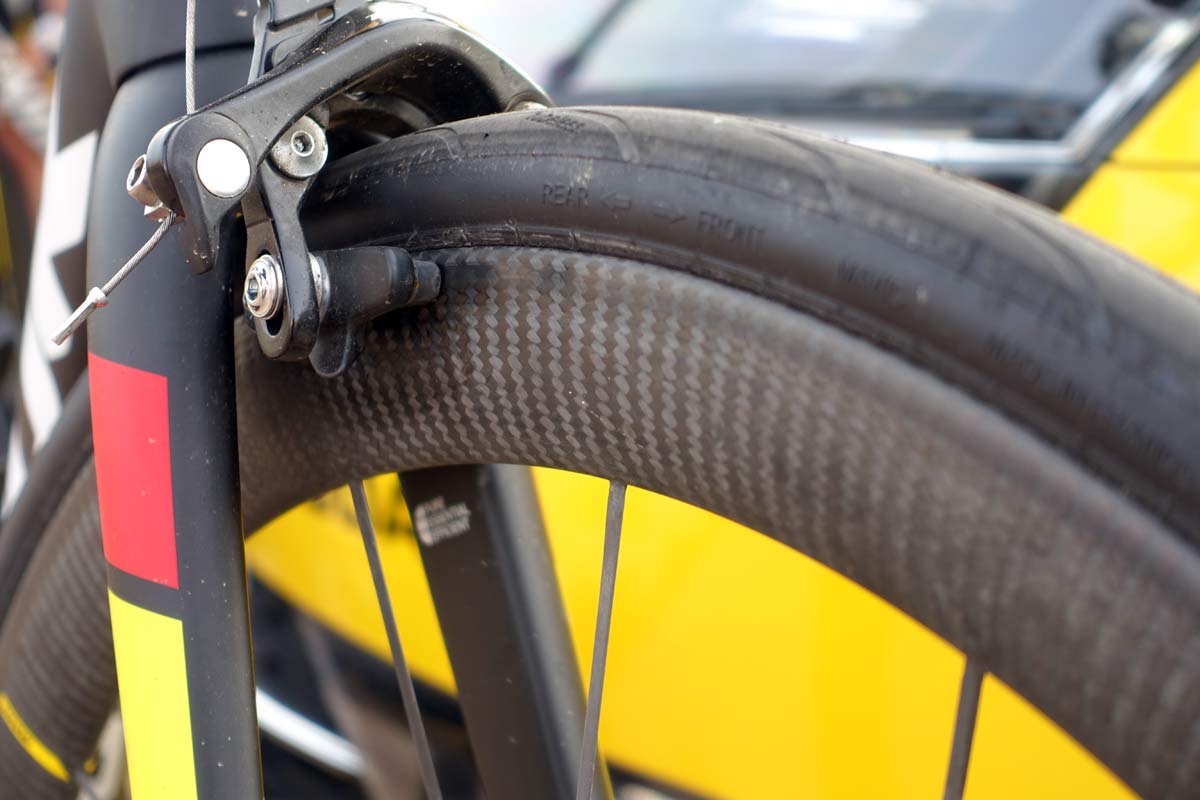We know, there’s no such thing as a stupid question. But there are some questions you might not want to ask your local shop or riding buddies. AASQ is our weekly series where we get to the bottom of your questions – serious or otherwise. Hit the link at the bottom of the post to submit your own question!
When it comes to rim brakes, friction is both your friend and your enemy. It’s your friend because without it, you obviously wouldn’t be able to stop. But it’s your enemy because that same friction causes heat and abrasion that will inevitably wear out your brake pads, or worse – destroy your rim.
One of the biggest problems with carbon clinchers has always been the potential for over cooking the rim on a long, steep descent. Ideally, you want to brake fast and hard rather than drag your brakes down the entire mountain, but in certain situations that’s easier said than done. And if you end up having to use your brakes a little too much on that descent, well that can lead to warped or bulging rims which seems to have happened this week’s AASQ provider, Christian.
“I have been riding a Fuji SL1 with carbon clinchers (Reynolds Assault) since 2009 with Cryo-Blue brake pads. Now this year I took part in the Tour de Corsica which had some really steep descents. As a result both wheels have developed bulges on the brake track. My question is should this be covered by Reynolds as a manufacturing defect?”
What causes carbon rims to bulge or change shape?
First things first. Before we answer whether this is a warranty issue, it’s important to know why this happens in the first place. With carbon rims, one of the biggest challenges in creating a full carbon rim is dealing with the heat build up caused by rim braking. There’s a reason why brands like HED took so long to develop their first one, because it’s hard.
Why? Because as the rim heats up during braking, the resin used to cure the wheel and hold all the layers of carbon together can soften. If it gets too soft, the rim can expand because the air pressure inside the tire overcomes the structural strength of the rim’s sidewall. Dragging your brakes for a long period of time builds up more heat, which is why short, hard braking is better for the health of your rim.

Most quality rim brands and manufacturers now use a resin with a very high Tg, or Glass Transition Temperature. This is the temperature at which a resin will change from a hard, glassy form into a softer, more malleable form. By testing rim temperatures in the lab, a brand can predict what the maximum real-world braking heat numbers will be and use a resin with a higher Tg than is likely to ever be seen on the streets. Some brands add other materials to help dissipate heat faster, too.
Or different designs. Mavic uses a fully molded rim bed, including the bead hook, so the fibers aren’t cut because they don’t need to machine the hook into the sidewall, a process that can weaken the structure.
Then, there’s rim wear to consider. In Christian’s case, he’s been riding these rims for a really long time, so chances are they’ve been worn down, too, and maybe the sidewalls aren’t as thick or strong as they once were.
Is carbon rim deformation a warranty issue?
That’ll depend on your brand’s warranty policy, so we’d recommend checking in with them. This is where sticking with a reputable brand can save the day. Sure, you can get cheap generic carbon rims (or other parts) online, but if you’re not sure where they’re really coming from (which is a topic for another day), then good luck getting them replaced if they break. Having back stock and customer service adds cost, as does R&D, which is why good rims and wheels cost more. You can think of it as insurance, both for your personal safety and in the event you need a replacement.
To get the answer for this particular case, we went straight to Reynolds. Here’s what they had to say:
Reynolds: First off, kudos to you for riding the same set of wheels for nearly ten years, awesome!
At the time of your purchase our warranty policy was 2 years. Had you done this damage to the wheels within that time frame, your wheels would have been covered under warranty. We’ve always had a very aggressive lifetime crash replacement policy, and also now have an Upgrade Program where you can replace your old Reynolds wheels with a new set for a significant discount. This way Reynolds riders have options to get back on their wheels and riding Reynolds even if they are older and out of warranty like yours.
Lastly, in 2017 we updated our warranty policy to not only be a Lifetime Warranty, but to cover all damage incurred while riding your bike.
In your case, I recommend either you, or your local shop, reach out to info@reynoldscycling.com or call our 800 number to get set up with our upgrade program and some new wheels and a lifetime warranty.
Next week, Giro’s answering your questions about helmets, so be sure to submit your questions here ASAP and we’ll get them answered from the experts on head safety!
Got a question of your own? Click here to use the AASQ form, or find the link under the Contact menu header up top anytime a question pops into your mind!

